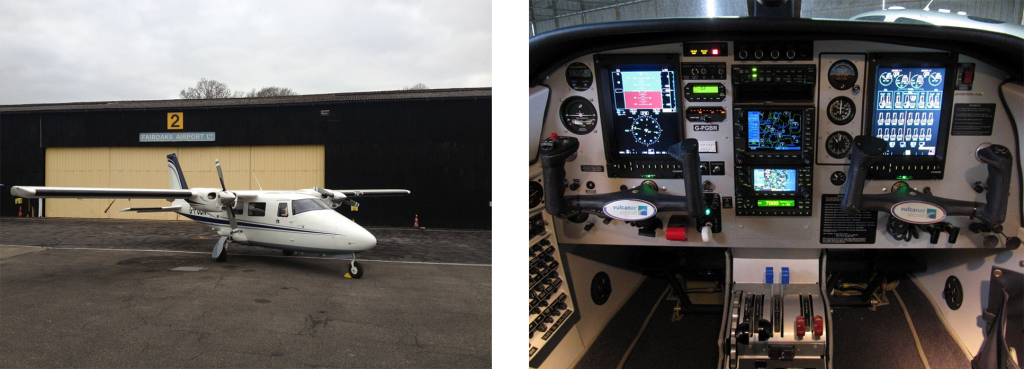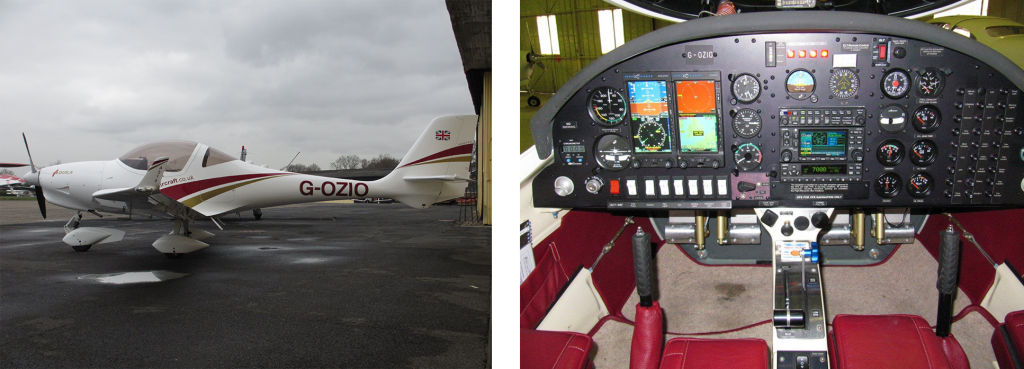Chobham Carnival
 Fairoaks Flight Centre took to the road last week with a stand at the Chobham Carnival. Marcus Almeida who manages the flight centre for Synergy Aviation commented, "it was great to be out in the community, talking about both Fairoaks and our flight training products. We were delighted with the number of experience flights we sold and look forward to taking our stand to other local events this summer."
Fairoaks Flight Centre took to the road last week with a stand at the Chobham Carnival. Marcus Almeida who manages the flight centre for Synergy Aviation commented, "it was great to be out in the community, talking about both Fairoaks and our flight training products. We were delighted with the number of experience flights we sold and look forward to taking our stand to other local events this summer."
One of the highlights of the day was a low level 'flyby' preformed by senior instructor Andy (with special permission from the CAA) which delighted the record crowd who had gathered in the Surrey sunshine.
Red Noses Come To Fairoaks!
On Saturday 23rd March 2013, Synergy Aviation were pleased to welcome and support students from Ashley CofE school in Walton who took part in a sponsored aircraft pull, raising money for comic relief. The event, organised by Grace Heavens and her friends, saw G-BOLV (Synergy Aviation's C152) being pulled down Taxiway Charlie to finish outside the Fairoaks Flight Centre with waiting friends and family offering their support and encouragement.
The ground crew at Fairoaks have a lot to live up to after their performance !
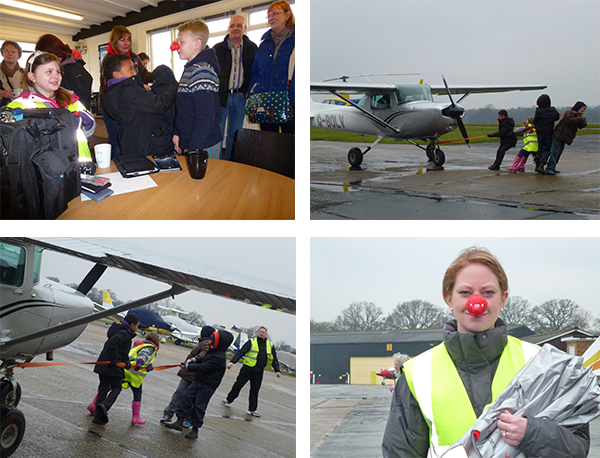
2010 Vulcanair P68 Retractable For Sale
Synergy Aviation is pleased to be managing the sale of G-PGBR, an ex-demonstrator aircraft with full 'glass cockpit'. As a demonstrator the aircraft was fitted from new with a multitude of optional extras.
The Vulcanair is a versatile High wing 6 seat aircraft with incredible range and large baggage bay. As the modern evolution of the Partenanvia, the Vulcanair can be operated in several configurations. G-PGBR’s designer leather seats can be fitted in various cabin layouts for VIP, cargo, surveillance or training operations. Originally designed as an ‘observer’ aircraft various camera hard points and camera holes can be fitted.
2010 Vulcanair P68 Ex-Demonstrator | Engine, Airframe & Prop: 80 Hrs | Lycoming IO-360 200HP, Glass Cockpit, TAS 600 Traffic, GNS530W, GNS340W, Heated Props & Wing Boots, Mode S, Leather Interior | Location: Fairoaks, UK | Price: 499,950 EUR + VAT
For further information please contact Glen Heavens at gh@synergyaviation.com or +44 7973 304 965.
2009 Aquila A210 NVFR For Sale
Synergy Aviation is pleased to be managing the sale of G-OZIO, an ex-demonstrator aircraft with Glass PFD & MFD. As a demonstrator the aircraft was fitted from new with a multitude of optional extras.
The Aquila A210 is a versatile machine, ideally suited to both training and touring. The spacious cockpit and the completely glazed canopy are impressive and offer excellent all-round-visibility. The aircraft has a generous baggage compartment with a lockable separate side door.
The aircraft has electric trim and a variable pitch propeller driven by the economical 100 hp Rotax 912S engine. The engine operates on both unleaded mogas and avgas. Fuel consumption in the cruise can be as low as 17 litres/ hour.
Engine, Airframe & Prop: 225 Hrs | Rotax 912S 100HP | Glass PFD & MFD, GNS 430, Mode S,ELT, Dual Alternators, Leather Interior, Tinted Canopy, MOGAS Approved | Location: Fairoaks,UK | Price: 89,950 GBP + VAT
For further information please contact Glen Heavens at gh@synergyaviation.com or +44 7973 304 965.
EGTF Easter 2013 Opening Hours
Easter Opening Hours for Fairoaks aerodrome operations are detailed below. Please note that Synergy Aviation will be open as normal (0900 -1800 Mon to Sat | 1000 - 1800 Sun) throughout this period for flight training, aircraft rental or cups of tea!
Friday 29 March 2013 : 0900-1800 normal services provided, NO circuit flying.
Saturday 30 March 2013 : 0800-1800 normal services provided.
Sunday 31 March 2013 : 0900-1800 normal services provided.
Monday 1 April 2013 : 0900-1800 normal services provided, NO circuit flying.
CAP797 – New FISO Manual
The CAA has recently produced a new manual of Flight Information Services (CAP797) which becomes effective on 1 April 2013. With this new manual, there are some changes to operational procedures used by FISOs that will be applicable to airfields such as Fairoaks operating under a Flight Information Service.
Below is an article from the CAA helping to clarify the different types of services available from UK airfields. Text outlined in bold italics draws attention to changes from the current FISO practice.
Look Who’s Talking
Kevin Crowley, an Air Traffic Standards Specialist at the Civil Aviation Authority takes a look at RT protocol and the importance of good communication.
Verbal misunderstandings never turn out that well, but in aviation they can be fatal. For a pilot, the difference between an instruction, and the supply of information, can mean the difference between a safe flight, and an incident or accident. As well as understanding what has been said, a pilot should also be aware of who has said it. Is that an Air Traffic Controller (ATCO), Flight Information Service Officer (FISO), or Air Ground Radio Operator you are talking to? Effective communication relies on a two way process, and as well as speaking a common language it helps if both parties are conscious of just who they are communicating with - this determines how a pilot should interpret the language used.
Many GA pilots, of course, operate quite happily in Class G airspace without needing to talk to anyone at all. However, many do need to use the radio to operate at their local aerodrome, and will receive an Air Traffic Control (ATC) Service, Aerodrome Flight Information Service (AFIS) or Air Ground Communication Service (AGCS). Knowing what to and what not to expect from each service, and the phraseology used in the provision of each service is something any pilot with a Radiotelephony licence will have covered in their training. However, knowledge fades and misconceptions creep in with time.
The UK Civil Aviation Authority (CAA) has recently published a new document, CAP 797 Flight Information Service Officer Manual, containing procedures and phraseology for use by a FISO, and can be found on the CAA website at www.caa.co.uk/CAP797. The manual is the result of an extensive consultation process with the aviation community and will have an impact for operations at all aerodromes providing an AFIS.
Although the new manual is primarily intended for use by FISOs, it makes interesting reading for general aviation pilots as it details the procedures and phraseology which they will encounter when operating at an aerodrome with an AFIS.
Looking at the various levels of service available at aerodromes, they can be identified from the radiotelephony callsign used, as follows:
ATC: ‘RADAR’, ‘APPROACH’, ‘TOWER’ or ‘GROUND’
AFIS: ‘INFORMATION’
AGCS: ‘RADIO’
So what exactly is the difference between ATC, AFIS, and AGCS?
AIR TRAFFIC CONTROL SERVICE
ATC provides instructions and clearances to assist in the prevention of collisions and to expedite and maintain an orderly flow of air traffic. Instructions and clearances from ATC to an aircraft on the ground, and whilst flying within controlled airspace and/or an Aerodrome Traffic Zone in Class G airspace, must be complied with at all times, unless the commander of the aircraft considers it unsafe to do so, in which case you must notify ATC. This includes compliance with the order in which ATC direct aircraft to approach to land and clearances to use the runway for take-off and landing.
If you are unsure of the clearance or instruction which has been passed, you must query it with ATC. Likewise if ATC communicate an order in which aircraft are to approach to land and you cannot see the traffic you are required to fit in behind, you must advise ATC, so that they can update you with the location of other traffic or communicate an alternative plan.
Whilst ATC will provide you with the location of other traffic which may affect your flight, not all aerodromes providing an ATC service will have the benefit of radar to see aircraft, therefore you must keep a good lookout for other aircraft in case they appear in a location which you were not expecting.
At an aerodrome with ATC you will hear the following phraseology when taking-off or landing:
‘Cleared for take-off’ – This is a clearance
‘Cleared to land’ – This is a clearance
You may also hear:
‘Go around I say again go around acknowledge’ – This is an instruction used when the air traffic controller considers it is not safe for you to continue your approach.
AERODROME FLIGHT INFORMATION SERVICE
AFIS provides instructions to aircraft only while manoeuvring on the apron, and taxiway up to the holding point, or on completion of the landing roll back to your parking area. These ground instructions may include the use of ‘Hold position’ when you are at the holding point, which you are required to comply with.
In all other circumstances AFIS provides information and advice only, useful for the safe and efficient conduct of flight.
When you have reported ready for departure and the Aerodrome FISO (AFISO) advises you that you may ‘take-off at your discretion’, do not assume it is safe to do so, it is your responsibility to evaluate any traffic information which they have passed and decide if it is safe to take-off. If you decide that this is not the case you must advise the AFISO accordingly and tell him/her that you are ‘holding’.
There may be occasions when you report ready for departure that the AFISO passes you information on relevant aerodrome traffic and requests you to ‘report lined up’ This may occur when an aircraft which has already landed has yet to vacate the runway. You must decide whether it is safe to enter the runway based on the information the AFISO has passed you. If in the example given, you feel there will not be sufficient time for the landed aircraft to vacate the runway and for you to take-off safely before the next landing aircraft you must advise the AFISO accordingly, advising him/her that you are ‘holding’. If you do enter the runway, the AFISO will then inform you either ‘Runway Occupied’ or ‘Take-off at your discretion’ when you report lined up, depending on the circumstances.
In the case of landing when you are advised ‘land at your discretion’, the AFISO is advising you that they do not know of any other traffic to affect your landing, but you must still decide if it is safe to do so whilst keeping a good lookout for any other traffic which may appear. Remember that the Rules of the Air do not permit two landing aircraft to be on the runway at the same time at an aerodrome providing AFIS or AGCS.
AFISOs are not permitted to instruct you to execute a go around and therefore you must make this decision if the landing area is occupied, or it is not safe to land for some other reason, advising the AFISO accordingly that you are executing a go around. Bearing this in mind, there may be an occasion where having passed ‘land at your discretion’ the AFISO receives a request from an agency requiring an emergency crossing of the runway, such as the aerodrome fire service attending an incident on the aerodrome. In such circumstances the AFISO will assess your distance from touchdown and may if they feel it is safe to do so, advise you ‘runway occupied’ and receive an acknowledgement from you before allowing the vehicle to cross the runway. Once the vehicle has crossed the runway and provided it is safe to do so they will advise you ‘Land at your discretion’. If at any time you consider it is not safe to continue your approach, it is your responsibility to execute a go-around and advise the AFISO accordingly.
In relation to backtracking a runway, an AFISO may instruct you to do so by use of the phraseology ‘Backtrack’ when you will be utilising the runway for taxiing. However when you have reported ready for departure, but require a backtrack because you are entering the runway at an intersection, the phraseology will be ‘At your discretion backtrack’. In the latter case you must assess the information which the AFISO has passed you on other aerodrome traffic and decide if there is sufficient time for you to safely backtrack the runway for departure, taking into account the next landing aircraft. If there is not then advise the AFISO accordingly, telling him/her that you are 'holding’.
When you are airborne and operating in the vicinity of the aerodrome, whether joining, leaving or operating in the aerodrome traffic pattern, the AFISO will provide you with information on other known aircraft operating in the vicinity of the aerodrome. An AFISO does not have a radar display so the information provided will be based on what he has been told by pilots; therefore you must keep a good lookout. You should also keep a good lookout for aircraft which may not have called the aerodrome and which the AFISO is therefore not aware of. It is important therefore when passing your own position, to be as accurate as possible as this will assist the AFISO and other aircraft in the vicinity to visually acquire your aircraft.
Pilots are responsible for safe integration with other aerodrome traffic and are required by the Rules of the Air to conform to the established traffic pattern. An overhead join may help in this respect, allowing you more time to visually acquire and integrate with other aerodrome traffic, but remember to check local procedures before getting airborne because local conditions such as airspace restrictions and other activities at the aerodrome may mean that another joining procedure is more appropriate.
Remember therefore, at an aerodrome with an AFIS you will hear the following phraseology when taking-off or landing:
‘Take-off at your discretion’ – This is advice and is not a clearance, you must decide if it is safe to do so
‘Land at your discretion’ – This is advice and is not a clearance, you must decide if it is safe to do so
AIR GROUND COMMUNICATION SERVICE
No instructions should ever be given by AGCS. The service only provides information to assist a pilot in safe conduct of his/her flight. Information provided on other traffic will be based on pilot reports and so a good lookout should be maintained both on the ground and in the air. Also bear in mind that AGCS operators often do not have a full and complete view of the aerodrome surface or its local airspace.
In summary, it is important that pilots are familiar with the services provided at aerodromes, that they assume responsibility for the safety of their flight, and at all times display good judgement and airmanship.
To further help pilots communicate effectively, the CAA also publishes a comprehensive reference guide to radiotelephony phraseology, CAP 413, which is available at www.caa.co.uk/cap413. It covers phrases to be used when arriving at and departing from aerodromes, flying cross country, operating at unattended aerodromes, carrying out instrument approaches and relaying emergency messages.
G1000 Training – Coming Soon
The Garmin G1000 is an all-glass avionics suite that brings new levels of situational awareness, simplicity and safety to the cockpit. Available for G1000 training, a 2010 Cessna 172 is shortly to join our fleet and will make an exciting addition to the options available for licenced pilots wanting to further their experience and skill set.
A training course of approximately 6 hrs ground theory and 3 hrs flying will be available that aims to introduce pilots to the G1000 philosophy, eventually leading to the G100o endorsement being added to the logbook. The aircraft is expected to join the fleet towards the end of November 2012 so stay tuned for further information on the course which will be released shortly.
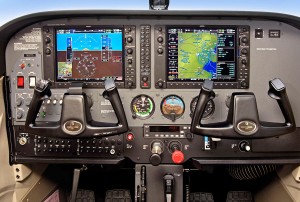
English Language Proficiency
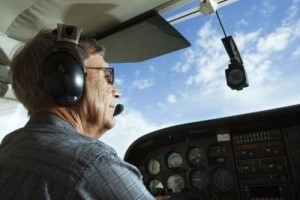 The following is applicable to all pilots with a licence issued before 2008.
The following is applicable to all pilots with a licence issued before 2008.
In order to comply with ICAO obligations, all UK pilots holding a FRTOL (Flight Radio Telephony Operators Licence) were automatically given an endorsement by the CAA in 2008 following a global ruling by ICAO requiring all pilots to formally demonstrate their knowledge of English language. This was a ‘Level 4’ endorsement that was only valid for four years unless renewed, and therefore will have expired in March 2012 for the majority of general aviation pilots.
Most commercial pilots will have been upgraded by flight test examiners to a Level 6 endorsement which is valid for life. However, for private pilots, unless a flight test has been undertaken in the last four years there is a high probability that the language proficiency has not been renewed.
Whilst the exact status of your English language proficiency on the CAA database can be obtained by phoning personnel licensing, the safest way of ensuring your licence is valid and compliant with the requirements is to submit SRG1199 to the CAA which shows a flight examiner has assessed your English language proficiency. For native speakers this will be to ‘Level 6’ which will not expire in the future.
All members with a licence issued before 2008 are recommended to request that SRG1199 is completed by an examiner which, on the condition of being assessed as Level 6, will be forwarded to the CAA to update their records and ensure licence validity is maintained.
Those with licences issued after 2008 will already have the required proficiency on your CAA record so no further action needs to be taken.
Members should email manager@flysynergy.com to arrange for the completion of the form and include in the email their CAA personal reference number.
Heathrow CTR Infringement
Description
On 28/08/2012, G-BGFX was being flown by a student pilot on a return trip from Goodwood (EGHR). During the latter stages of the flight, an infringement of the London CTR occurred and the following is a description of the event from the student who was flying solo at the time. The student has kindly agreed for the event to be shared with the intention that pilots can learn from the two main factors that contributed to the infringement.
"As I routed up from Goodwood to Guildford I continued to follow the heading on my Directional Indicator as calculated and entered into my plog. However, the DI (without my current realisation) had started to drift significantly. As a result, I drifted off track and subsequently lost track of my position. As I started to concentrate on locating my position I lost track of time and therefore position along route. When I realised I was significantly off track/lost I tried to provide myself with a position fix using the VOR/DME in the aircraft. In doing so however, I managed to knock the toggle-switch of the radio's audio to the OFF position, and in doing so virtually turning my radio's off without my knowledge. Now being very lost I tried to contact Farnborough Radar to ask for assistance to receive no communications due to the state of the radio's. Then as I tried to focus on fixing the radio issue I flew into the Heathrow CTR without knowing. Once two-way communication was restored with Farnborough Radar, they assisted me in removing myself from controlled airspace by performing timed turns as the DI was deemed U/S at this stage and I could not work out a westerly direction which was required for me to fly. Farnborough Radar then continued to help me all the way back into the Fairoaks circuit."
Factor 1: DI / Compass Checks
The 'drift' experienced on the direction indicator resulted in the pilot flying an incorrect heading and thus departing from the planned track.
The direction indicators (DI) are affected by gyroscopic precession which will cause the instrument to precess over a 10 - 15 minute period. As a result, the direction indicator should always be re-aligned with the compass during the FREDA check, remembering that it should only be re-aligned when in straight and level, unaccelerated flight. It is also good practice to perform a DI / compass check before turing onto a new track.
Factor 2: Comm Audio Selection
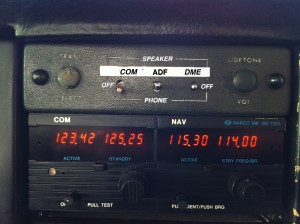 The loss of communication was a result of inadvertently selecting the comm audio to OFF. The following image shows a common Cessna 152 audio panel arrangement. At the top of the unit are the selectors for the COM, ADF and DME audio. Each toggle switch has three positions; Speaker (Top), OFF (Middle) and Phone (Bottom). During normal operation, the COM selector should be in 'Phone' position so that the air traffic audio is transmitted through the headset.
The loss of communication was a result of inadvertently selecting the comm audio to OFF. The following image shows a common Cessna 152 audio panel arrangement. At the top of the unit are the selectors for the COM, ADF and DME audio. Each toggle switch has three positions; Speaker (Top), OFF (Middle) and Phone (Bottom). During normal operation, the COM selector should be in 'Phone' position so that the air traffic audio is transmitted through the headset.
It has been known for the COM selector to accidentally be nudged into the OFF position during a frequency change or similar action. This will result in being unable to hear the transmission of ATC. For this reason, if a radio failure is suspected, a check should be made as to the postion of these switches.
Future Flyers and Fixers
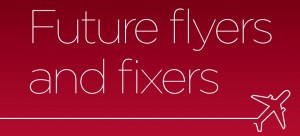
Synergy Aviation is pleased to announce our support of the Virgin Atlantic 'Future Flyers and Fixers' event. The event, due to take place on Saturday 24th November 2012, is aimed at young persons between the ages of 13 and 25 interested in a career in aviation.
Leading Flight Training Organisations and prominent persons from the airline industry will help you discover if a career in aviation is for you.
Please email futureflyers.andfixers@fly.virgin.com for further information and view the event poster.

